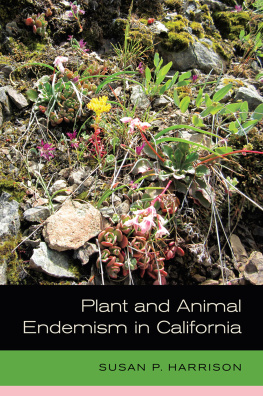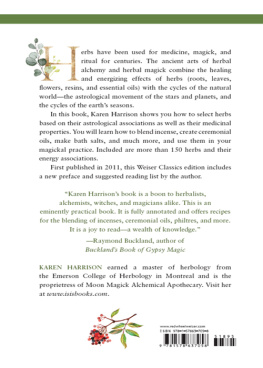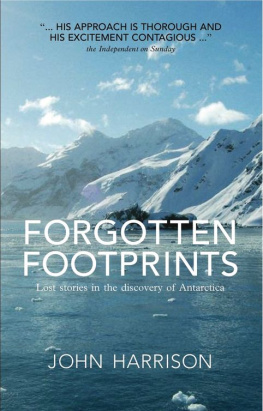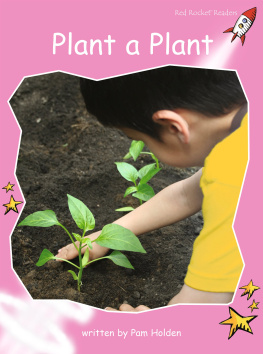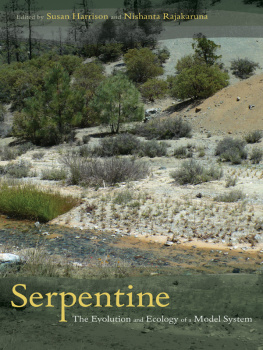Harrison - Plant and Animal Endemism in California
Here you can read online Harrison - Plant and Animal Endemism in California full text of the book (entire story) in english for free. Download pdf and epub, get meaning, cover and reviews about this ebook. City: Berkeley, year: 2013, publisher: University of California Press, genre: Romance novel. Description of the work, (preface) as well as reviews are available. Best literature library LitArk.com created for fans of good reading and offers a wide selection of genres:
Romance novel
Science fiction
Adventure
Detective
Science
History
Home and family
Prose
Art
Politics
Computer
Non-fiction
Religion
Business
Children
Humor
Choose a favorite category and find really read worthwhile books. Enjoy immersion in the world of imagination, feel the emotions of the characters or learn something new for yourself, make an fascinating discovery.
- Book:Plant and Animal Endemism in California
- Author:
- Publisher:University of California Press
- Genre:
- Year:2013
- City:Berkeley
- Rating:4 / 5
- Favourites:Add to favourites
- Your mark:
- 80
- 1
- 2
- 3
- 4
- 5
Plant and Animal Endemism in California: summary, description and annotation
We offer to read an annotation, description, summary or preface (depends on what the author of the book "Plant and Animal Endemism in California" wrote himself). If you haven't found the necessary information about the book — write in the comments, we will try to find it.
Plant and Animal Endemism in California — read online for free the complete book (whole text) full work
Below is the text of the book, divided by pages. System saving the place of the last page read, allows you to conveniently read the book "Plant and Animal Endemism in California" online for free, without having to search again every time where you left off. Put a bookmark, and you can go to the page where you finished reading at any time.
Font size:
Interval:
Bookmark:

Plant and Animal Endemism in California
Plant and Animal
Endemism in California
Susan P. Harrison

UNIVERSITY OF CALIFORNIA PRESS
BerkeleyLos AngelesLondon
University of California Press, one of the most distinguished university presses in the United States, enriches lives around the world by advancing scholarship in the humanities, social sciences, and natural sciences. Its activities are supported by the UC Press Foundation and by philanthropic contributions from individuals and institutions. For more information, visit www.ucpress.edu.
University of California Press
Berkeley and Los Angeles, California
University of California Press, Ltd.
London, England
2013 by The Regents of the University of California
Library of Congress Cataloging-in-Publication Data
Harrison, Susan (Susan Patricia)
Plant and animal endemism in California / Susan Harrison.
pages cm
Includes bibliographical references and index.
ISBN 978-0-520-27554-6 (cloth : alkaline paper)
eISBN 9780520954731
1. Endemic plantsCalifornia. 2. Endemic animalsCalifornia. 3. Endemic plantsEcologyCalifornia. 4. Endemic animalsEcologyCalifornia. 5. Endemic plantsConservationCalifornia. 6. Endemic animalsConservationCalifornia. I. Title.
QK149.H444 2013
581.9794dc23
2012043370
Manufactured in the United States of America
22 21 20 19 18 17 16 15 14 13
10 9 8 7 6 5 4 3 2 1
The paper used in this publication meets the minimum requirements of ANSI/NISO Z 39.481992 ( R 2002) ( Permanence of Paper ).
Cover image: Sickle-leaved onion ( Allium falcifolium ), Oregon stonecrop ( Sedum oreganum ), and Siskiyou bitterroot ( Lewisia cotyledon ), members of three genera rich in Californian endemics.
Contents
Preface and Acknowledgments
Why write about endemism in California? Asked by a group of friendly but critical graduate students during a seminar visit, this question struck me as worth thinking about before beginning to write. Ecologists and evolutionists usually focus on broad, theory-driven questions. Isnt it small-minded to focus on a place, let alone a place defined by human-drawn boundaries? And what about endemism, which the dictionary defines as the condition of being native or restricted to a certain place? Every species is endemic to somewhere, so what makes Californian endemism interesting?
My answers will be familiar to many readers, but perhaps not to all, as my experience with the out-of-state graduate students suggests. California is not just a political unit; uniquely among U.S. states, it is also more or less its own biogeographic region. More precisely, the state largely coincides with the California Floristic Province, one of only five regions in the world where the mediterranean climate is found. (This book considers endemism in the California Floristic Province wherever possible but concentrates largely on endemism in the state of California simply because of the greater availability of data at the state level.) The mediterranean biome worldwide is outstanding for its botanical uniqueness; it holds an estimated 20 percent of the worlds vascular plants in only 2 percent of the worlds land area. Some of this biomes most distinctive groups of plants are thought to be evolving rapidly, and many classic studies of plant evolution and speciation have emerged from California. Finally, California has been the site of scientific and policy experiments aimed at the conservation of biological diversity, in part because traditional approaches to conservation are challenged by the sheer abundance and diffuse distribution of rare species in the state.
This book is motivated by the aim to learn new lessons at the interface of evolution, ecology, and conservation by examining California. Thus it focuses on analyzing patterns and addressing general questions, as outlined in the introduction. What this book does not do is explore the states rich natural history in any great depth; that has already been done well by many authors. Readers are directed, for example, to Elna Bakkers An Island Called California, Allan Schoenherrs Natural History of California and Schoenherr and colleagues Natural History of the Islands of California, Peter Dallmans Plant Life in the Worlds Mediterranean Climates, and the entire California Natural History Guides series published by UC Press. Key resources for data on the states species and habitats are the Department of Fish and Wildlife (www.dfg.ca.gov/biogeodata), the Native Plant Society (www.rareplants.cnps.org), and the Calflora project (www.calflora.org).
The botanical bias of this book has to be admitted at the outset. Reasons for this are probably obvious: the long history of studying endemism in California and even of treating California as a biogeographic unit has been largely the work of plant-oriented scientists. Not coincidentally, as Chapters 3 and 4 discuss, Californian endemism is more pronounced in plants than in most animal groups. It is no coincidence, then, that a plant person should attempt a book on Californian endemism. Your author freely admits to having studied Californian plant diversity for the past fifteen years, although my degrees are in zoology, ecology, and biology, and my masters and PhD work was on insect ecology. Please dont close the cover, animal lovers; you will find here never before compiled material on the states winged, finned, and four- to eight-legged inhabitants. Contemplating the contrasts between plant and animal endemism has been an enjoyable exercise that I hope will interest you as well.
This book was made possible by the generosity of many people. Expert knowledge and data came from Bruce Baldwin, Roxanne Bittman, David Bunn, Frank Davis, Tom Gardali, Terry Griswold, Brenda Johnson, Doug Kelt, Lynn Kimsey, Tim Manolis, Richard Moe, Peter Moyle, Paul Opler, Monica Parisi, Jerry Powell, Greg Pauly, Gordon Pratt, Jim Quinn, Steve Schoenig, Nathan Seavy, Art Shapiro, Aaron Sims, Robert Thomson, James Thorne, Robbin Thorp, Darrell Ubick, Dirk Van Vuren, Phil Ward, David Wake, and David Weissman. The new list of California Floristic Province endemic plants was generously created by Dylan Burge, and the Baja California data were kindly updated by Bart OBrien. Artwork (or data for artwork) was generously provided by Bruce Baldwin, Ron Blakey, Dylan Burge, Paul Fine, Kathy Keatley Garvey, Brad Hawkins, Lynn Kutner, Ryan ODell, Brody Sandel, Cristina Sandoval, Aaron Schusteff, Zack Steel, David Wake, David Weissman, Darrell Ubick, Joseph Vondracek, and James Zachos. Assistance with data processing was given by Brian Anacker, Erica Case, and Brandon Sepp, and illustration help was provided by Steven Oerding and Marko Spasojevic. Kind yet helpful comments on early drafts were given by Howard Cornell, Peter Moyle, Philip Rundel, Mark Stromberg, and John Thompson. Chuck Crumly and Lynn Meinhardt at UC Press shepherded this book through its many stages. Finally, this book is dedicated to all those who have worked to understand and conserve the Californian (in the broad sense) flora and fauna... you know who you are!
Introduction
Endemism or biological uniqueness is woven into what most people think of when they hear California. Along with Hollywood, the Golden Gate Bridge, and wineries, even nonbiologists might think of coastal redwoods, condors, and fields of orange poppies in their imaginings of the state. Almost anything famously Californian has some connection to the wealth of unique species. The pleasantly winter-wet / summer-dry (mediterranean) climate, for example, is found in only five places in the world; it invariably means not only excellent wines and dense human populations, but an abundance of native plant species adapted to the long dry season. Hollywood is named after an endemic plant with the characteristic mediterranean climate trait of thick evergreen leaves (toyon, Heteromeles californica, one of over 300 plants with the species name californica or californicus ). The fog shrouding the coastal redwoods hints at an ancient, wetter, less seasonal climate that also figures importantly in explaining the states biological riches. Then theres geology; an active plate tectonic margin laid the groundwork, literally, for Californias frequent earthquakes and history-making gold rush and the granite pinnacles of Yosemite. Geologic forces also created the array of past and present barriers, including the Golden Gate, Monterey Bay, mountain ranges, and deserts, that not only gave the state spectacular scenery but also split ancestral plant and animal lineages into todays diverse suites of species. Geologic upheaval also gave rise to the states dramatic variety in climates, bedrock, and Soils, producing the most diverse agricultural region in the world and creating equally diverse habitats for native species.
Next pageFont size:
Interval:
Bookmark:
Similar books «Plant and Animal Endemism in California»
Look at similar books to Plant and Animal Endemism in California. We have selected literature similar in name and meaning in the hope of providing readers with more options to find new, interesting, not yet read works.
Discussion, reviews of the book Plant and Animal Endemism in California and just readers' own opinions. Leave your comments, write what you think about the work, its meaning or the main characters. Specify what exactly you liked and what you didn't like, and why you think so.

